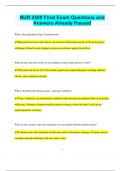NUR 2500 Final Exam Questions and
Answers Already Passed
What is the pathophysiology of hypertension?
✔✔Hypertension occurs when there is an increase in blood pressure due to the narrowing or
stiffening of blood vessels, leading to increased resistance against blood flow.
What are the main risk factors for developing coronary artery disease (CAD)?
✔✔The main risk factors for CAD include hypertension, high cholesterol, smoking, diabetes,
obesity, and a sedentary lifestyle.
What is the difference between type 1 and type 2 diabetes?
✔✔Type 1 diabetes is an autoimmune condition where the pancreas produces little or no insulin,
while type 2 diabetes is characterized by insulin resistance, where the body’s cells do not
respond properly to insulin.
What are the common signs and symptoms of a myocardial infarction (heart attack)?
✔✔Common signs and symptoms include chest pain or discomfort, shortness of breath, nausea,
sweating, and pain radiating to the arm, neck, or jaw.
1
,What is the pathophysiology of chronic obstructive pulmonary disease (COPD)?
✔✔COPD is a progressive lung disease that involves the obstruction of airflow, typically due to
chronic bronchitis or emphysema, leading to decreased oxygen exchange and difficulty
breathing.
What is the function of the liver in the body?
✔✔The liver processes nutrients from food, produces bile to aid digestion, detoxifies harmful
substances, and helps regulate blood sugar levels.
What are the stages of chronic kidney disease (CKD)?
✔✔The stages of CKD are based on the glomerular filtration rate (GFR) and range from Stage 1
(mild damage) to Stage 5 (kidney failure or end-stage renal disease).
What is the purpose of hemodialysis?
✔✔Hemodialysis is a treatment used to filter and remove waste products and excess fluids from
the blood in patients with kidney failure.
What is the difference between benign and malignant tumors?
2
,✔✔Benign tumors are non-cancerous and do not spread to other parts of the body, while
malignant tumors are cancerous, grow uncontrollably, and can invade nearby tissues or
metastasize.
What are the signs of hypoglycemia?
✔✔Signs of hypoglycemia include shaking, sweating, dizziness, confusion, irritability, hunger,
and in severe cases, unconsciousness or seizures.
What is the significance of monitoring electrolyte levels in patients with heart failure?
✔✔Monitoring electrolytes is important because imbalances, especially in sodium and
potassium, can affect heart function, increasing the risk of arrhythmias and worsening heart
failure.
What is the purpose of administering a beta-blocker in patients with heart failure?
✔✔Beta-blockers are used to slow the heart rate, reduce blood pressure, and decrease the heart's
workload, improving heart function and symptoms in heart failure patients.
How does insulin work in the body?
3
, ✔✔Insulin helps glucose from the bloodstream enter the cells to be used for energy or stored for
later use, thus lowering blood sugar levels.
What is the role of diuretics in treating hypertension?
✔✔Diuretics help reduce blood pressure by increasing the excretion of sodium and water from
the body, thereby lowering the volume of fluid in the blood vessels.
What is the Glasgow Coma Scale (GCS) used for?
✔✔The GCS is used to assess the level of consciousness in a patient by evaluating eye, verbal,
and motor responses.
What is the difference between Crohn's disease and ulcerative colitis?
✔✔Crohn's disease can affect any part of the gastrointestinal tract, while ulcerative colitis is
limited to the colon and rectum. Both are types of inflammatory bowel disease (IBD), but
Crohn's often involves deeper layers of the bowel wall.
What are the early signs of shock?
✔✔Early signs of shock include rapid pulse, low blood pressure, cold and clammy skin, rapid
breathing, and confusion or anxiety.
4




